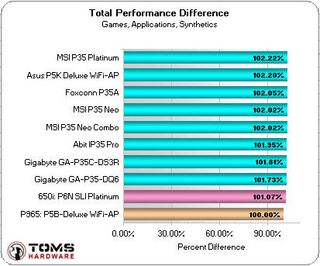Eight P35-DDR2 Motherboards Compared
Performance Summary, Continued
Most buyers will use their systems for a combination of tasks, so let's take a look at the "big picture", with all the performance differences averaged.

Note: Thanks to TG Forumz member p4rry for pointing out a glitch in the charts that had previously lead us to the wrong conclusion.
The MSI P35 Platinum gets the best overall performance rating, at 2.22% ahead of the least-performing P965 comparison board. Perhaps we should have chosen our P965 board based on performance rather than overclocking, but we really wanted to see "how much higher" the best P35 boards would clock than the top P965 versions they replace.
Adjusting for the P35 Platinum's slight 0.1% overclock, its actual performance lead over the lowest board is 2.13%. This puts MSI below Asus until we remember that the P5K WiFi-AP is overclocked even farther, by 0.24%. Adjusting the P5K's performance lead to negate its overclocking, drops its lead over the slowest board to 1.96%. MSI still wins at the high end, and Foxconn's surprising second-place finish (even after adjusting for the P35A's 0.1% overclock) should make value-seekers very happy.
The "significant" performance gain the P35 Compare Prices on P35 Motherboards had over the chosen P965 platform can partly be blamed on the fact that we chose a top overclocking P965 board, rather than a top-performing version. P35 boards were all within 1% of each other in performance. Differences that small are meaningless. But what about overclocking?

The Gigabyte GA-P35-DQ6 takes the overclocking crown by the smallest margin, and the same company's GA-P35C-DS3R comes in second place. Abit also made a good showing, as did Asus' old P965 Express-based P5B Deluxe WiFi-AP Edition motherboard.
Conclusion
An insignificant performance lead for the MSI P35 Platinum might be nullified by the fact that the same board finished near the bottom in overclocking, a repeat of the performance seen in the company's previous P965 Platinum. With less than one-half percent performance difference, Gigabyte's exceptionally-overclockable GA-P35-DQ6 is probably a better choice for anyone who'd even consider tinkering with bus speeds.
Stay on the Cutting Edge
Join the experts who read Tom's Hardware for the inside track on enthusiast PC tech news — and have for over 25 years. We'll send breaking news and in-depth reviews of CPUs, GPUs, AI, maker hardware and more straight to your inbox.
Many users are looking for a reason to upgrade, and quite a few already own a P965 Express based motherboard. The P35 Express chipset did well, but its tiny performance lead fails to impress. The P35 Express chipset's raison d'être is FSB1333 compatibility, but the vast majority of "performance" P965 Express motherboards can easily be overclocked to speeds well beyond this basic compatibility.
Another reason to choose the P35 Express over the P965 Express is support for DDR3 memory, but this round compared DDR2 configurations. DDR3 memory is still in it infancy, suffering from horrible latency compared to DDR2. FSB1333 processors will work fine with memory as slow as DDR2-667, so long as it's in dual-channel mode and has latencies of CAS4 or better.
Perhaps Gigabyte's DDR2 plus DDR3 supporting GA-P35C-DS3R is worth a closer look because it can use today's top-performing DDR2 memory while maintaining future compatibility with faster DDR3 modules, overclocks extremely well, and puts up good overall performance numbers? The tiny performance differences between chipset generations mean the majority of users who already own P965-Express motherboards will be best-advised to wait for Intel's next chipset before considering the DDR3 plunge.
Current page: Performance Summary, Continued
Prev Page Performance SummaryMost Popular


